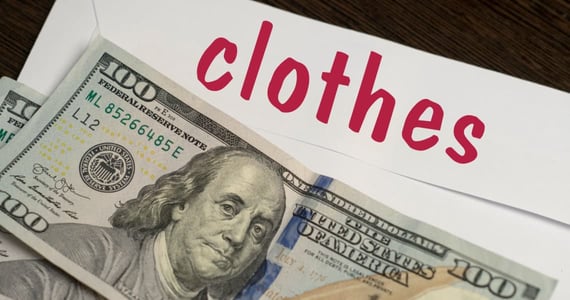
Credit cards, debit cards, and electronic payments are safe and convenient tools, but when you make transactions with them, you can lose touch with your money. Even with a good tracking system, it’s easy to stray from your budget and end up overspending.
Then you become frustrated, wondering where all your money goes. You should have enough for everything, so what’s going on?
If this sounds familiar, consider giving a low-tech solution a try. It’s called the cash envelope system, and here’s how it can work for you.
What is the Cash Envelope System?
The envelope system is generally for expenses that fluctuate — also known as discretionary spending — and that you can adjust with different shopping strategies. It isn’t for fixed expenditures such as rent, car payments, or streaming services.
If you don’t manage your discretionary spending carefully, it can spin out of control. When that happens, you can exceed your budget and won’t have enough money left over for your fixed expenses. At that stage, you may end up borrowing the difference and getting into expensive debt.
But with the cash envelope system, all that can be avoided.
The cash envelope system is all about organization and setting personal limits. It’s also basic, requiring just a box of envelopes, a pen, and cash. Even better, you don’t need to qualify for a loan or a credit card, download an app, or set up a complicated spreadsheet.
All you do is put a certain sum of money in a series of envelopes marked with different expense categories. The amount you put in is the maximum you have allowed yourself to spend in each category for the month.

If you stuffed $200 in an envelope labeled restaurants, you know in advance that you have this amount for dining out each month. You can spend less than the amount in the envelope, but not more.
How to Set Up a Cash Envelope System
Step one is to review your entire budget. Make a list of everything you spend your money on in a given month, and subtract that figure from your net monthly income.
Be conservative with your numbers. They should realistically match what you need and want.
Now consider which expenses you should create envelopes for. These should be the expenses that you may overspend on if you’re not ultra-conscious. Typical categories include:
- Groceries
- Dining and drinking out
- Entertainment, such as movies and sporting events
- Clothing and accessories
- Personal care, such as haircuts, manicures, and massages
- Holidays and gifts
- Trips and vacations
Once you’ve determined the categories, take out the envelopes and label them with the category and the amount allotted for one. For example, you may allow yourself to spend $800 a month on groceries while your budget for clothes and accessories may be $200.
Because this is a cash-based method, you’ll have to take a trip or two to the ATM so you can withdraw the amount you need to place into the envelopes.
As soon as you have your envelopes filled with the right amount of cash, you can start to use it for what you need. If you go to the supermarket every Saturday, take out enough for the week’s groceries and leave the rest in a secure place.
Your aim is to keep your spending to the amounts in your envelopes, but if you have leftover cash at the end of the month, you can consider that play money. What other category would you like to beef up? Or take out another envelope and write the word “savings” on it, then put all extra cash into it. Eventually, you can decide what to do with that money.
Here’s a tip when you are shopping with cash: Remember the receipts and keep them in an accessible place. You may need them as proof of payment for returns and for tax deduction purposes. You won’t have the accounting trail that you do with credit and debit cards.
Try the Cash Envelope System for 6 Months
The cash envelope system can be a great way to gain control over a haphazard budget. You won’t be charging your expenses, so you can be at ease that you are not acquiring debt.
As you try the system, ask yourself how you feel along the way. Do you really want to spend as much as you are on things such as entertainment or gifts?
You may be shocked to discover that you spend far more than you thought on certain categories. You may run out of funds but still have weeks left. At that stage, you can take from other envelopes and adjust your budgeting for those categories.
This system can lead to many aha moments. You just may find yourself standing in the supermarket evaluating prices like you never have before.

If you’ve got $225 in your envelope, as you add items to your cart, you will be calculating what it all costs so you’re not short when you get to the cash register. The $8 artisan strawberry preserves may not be worth it when compared to the jar on sale for $3.
Consider the cash envelope system as your opportunity to evaluate what is truly important to you. Continuously adjust the categories and the amount of cash you put into the envelopes until it makes the most sense. Maybe your Saturday coffee date with friends is more valuable than your mani-pedi.
Whatever the case, in six months, you should have an accurate idea of where your money is going and what you most want to do with it.
Transition to Different Payment Methods When You’re Ready
There are a couple of downsides to the cash envelope system. One is that it can take the place of using credit cards.
If you aren’t repaying a loan or other existing debt, you won’t be adding information to your credit reports. Without that information, your credit scores can decline because the data on those reports is what determines your scores.
So when you feel prepared, you can begin to integrate credit cards into your life again. But keep the budgeting skills and habits you have developed with the cash envelope system.
For example, if you know you can spend $100 a month on personal care without stressing your budget, you can use your credit card to pay for those things and services. Stick to the same amount you added to the envelope, and then pay off the bill in full. You can wait until the bill comes due or pay as you go so you don’t have to face a big balance all at once.
Either way, you can be certain that positive information will be added to your credit report, with a perfect payment schedule and no revolving debt. And if the card offers rewards in the form of points or miles or cash back, you will also profit from those, which is impossible with cash.
Another disadvantage of the cash envelope system is that carrying large sums of money can be risky. Keep the envelopes in a secure and private place in your home (a lockbox is perfect), and never lose sight of the envelope when you are shopping.
If you misplace the money or it is stolen, the odds of having it returned are slim. When you pay with credit cards or debit cards, you can report fraudulent activity and not forfeit any funds.
And, of course, you can’t use cash when shopping from eCommerce websites, so you may lose out on special deals that are only available online.
Keep on Keeping Track
Feeling disconnected from your money is never good. The cash envelope system teaches you to always be in touch, knowing the amount you have to spend and how much is already gone.
When you switch back to credit, debit, and electronic forms of payment, commit to being ultra-aware of how much money is in your bank account. Check your balance regularly. A daily or weekly review using your bank’s app is smart.
And if you ever find your budget slipping again, you can always return to the cash-based system you learned. It’s like returning to boot camp. Sometimes you just need to build up those financial muscles again.




